Last Updated on June 8, 2023 by Georgie Smith
When winter is approaching, a well-cured, ample stack of firewood equals peace of mind for a homesteader focused on living a self-sufficient lifestyle.
Homeowners that heat their homes with wood spend about half the costs as those who use more traditional sources of propane, oil, or electric baseboard heaters. Some homesteaders use wood heat as their only source of heat.
Even on-the-grid, heating with a wood stove can supplement other heating sources and significantly reduce a homeowner’s total overall winter energy costs.
But to fuel a wood stove, especially through a long, cold winter, homesteaders need a good source of firewood, put up well before winter sets in, prepared and stored correctly.
Accounts
Free Trial
Projects
SSL
Makita XCU03PT
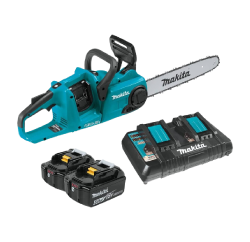
Brand - Makita
Battery Powered
Horsepower - 3.2 hp
Weight - 16 Pounds
WEN 56207 6.5
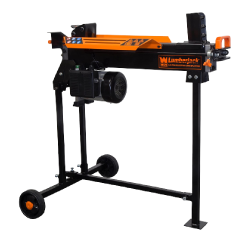
Electric Log
Color - Black
Easy to use
Weight - 98 pounds
Work Gloves
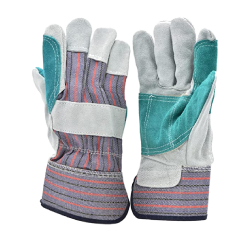
Leather, Rubber
Work Gloves
Reusable
Large (Pack of 5)
What Kind of Firewood is Best?
All wood burns. But some firewood does it a lot easier, and more economically, than others.
No matter what kind of wood you choose, the first rule of thumb is it should be seasoned.
Green, or recently felled and cut lumber, will have a high percentage of water. Up to almost 50 percent of freshly cut wood is made up of water, versus seasoned wood has 20 to 25 percent water mass.
While you can burn green wood, seasoned wood is easier to start and burns cleaner and hotter, which makes it more efficient. Also, unseasoned firewood creates steam that can build up as creosote in your chimney, leading to future problems.
Ideally, firewood should be stored for six months or more to allow the sun and air to naturally evaporate that extra, unneeded water that may cause problems in the future.
Tips for Buying Seasoned Firewood
You can either buy seasoned firewood or buy green firewood and plan to season it yourself. Not surprisingly, seasoned wood is more expensive than green firewood. So, if you are going to spend more money than seasoned, it is vital to get what you pay for.
Tips for Checking for Seasoned Firewood
- Seasoned firewood will feel lighter than expected in your hand versus green firewood feels heavy.
- When two pieces are struck together, seasoned firewood will make a clear hollow ‘clank’ rather than a dull ‘thud’ sound.
- Seasoned firewood will generally have cracks and splits visibly with darkened ends.
- Seasoned firewood is light in color, and bark will easily pull off (or even fall off)
- Unseasoned firewood will often have green, dark areas and the bark will be tight and not easily removed.
If you decide to buy green firewood, or you fell some trees on your property and plan to chop your own firewood, then season it yourself.
Tips for Seasoning Your Firewood
- Timing is the most important element. Ideally, cut your firewood in the spring before you plan to use it, so it has about six months to cure. Even better yet, give it a year to cure.
- Split it. It should be cut and split to size. Split pieces of wood will dry out much more quickly than unsplit logs cut right before you want to burn them.
- Stack it. Up, off the ground for good exposure to airflow.
- Cover it. Tarp the top to keep the rain off.
What Species of Wood is Best for Firewood
Any type of wood will burn. But some species burn better than others. A large part of your choice for firewood will be what you have access to in your region.
Softwoods Versus Hardwoods for Firewood
Softwoods are evergreen species that don’t lose their leaves like pine, fir, and cedar. Versus hardwoods are species with generally broad leaves that do lose their leaves in the fall like maples and oaks.
Hardwood species are often considered “best” for firewood because they are denser and create a hotter, longer-lasting fire that will create a lot of coals. They are suitable for banking a fire overnight to last until morning. Softwoods are lighter and have more resin. This means they will light easier but burn faster, with larger, crackling flames.
The other thing to consider is that hardwood – because it is denser – will take longer to cure (ideally a year) whereas softwoods dry out and season quickly.
In the end, it will come down to what you have access to in your region. If you decide to use softwood, you will need to calculate more firewood for your heating needs because you will burn through it faster. The typical rule of thumb is twice the volume of softwoods versus hardwoods. That will equate to not only more wood but more splitting and stacking too.
How Much Firewood Do I Need?
One of the biggest questions, especially for your first winter using wood heat, is how much firewood will you need to get through?
There are many variables to that equation, including your home’s insulation, the efficiency of your wood stove, whether you use other heating sources or just wood heat, and also, simply, how warm you like your home to be!
The basic rule of thumb is three cords of wood for the winter season. This equals about one cord burned every 30 to 60 days. For very efficient wood stoves, you may need only one cord to get through the entire winter. On the other hand, homeowners entirely dependent on wood heat, with a large or inefficient home, and in an extended, cold winter region may burn as much as five to seven cords.
In the end, if you purchase too much wood than you end up using, it can always be used the following winter. So there is no downside to over-supplying your firewood needs other than the purchase cost and labor required to split and stack it if you do it all yourself.
How to Buy and Find Firewood Near You
The first decision to make is whether you want to buy firewood that is cut and, ideally, seasoned. Or do you want to source your own trees and cut your own?
If time is at a premium, then sourcing precut firewood will likely be the way to go. You will need to know what to look for, how to price it, and understand all the terminology!
Common Firewood Terminology
- A Cord. The standard measurement for firewood. A cord is 128 cubic feet of dried, well-stacked firewood — Officially, a cord is measured at 4’x 4′ x 8,’ but since firewood is rarely sold at 4′ length, there are many additional terms typically used when buying (and measuring) volumes of firewood.
- A Face Cord (also sometimes called a rick or fireplace cord) — Measured at 4′ high x 8′ wide but no specific depth. Typically considered at 1/3 of a regular cord.
- A Thrown Cord — Literally a loose ‘thrown’ stack of wood (usually into the back of a pick-up truck). The basic rule of thumb is a ‘thrown’ stack of wood takes up 30 percent more than the same wood when stacked neatly. So, for instance, 128 cubic foot “cord” of wood will measure at about 180 cubic feet when in a loose ‘pile.’ Roughly!
- A Green Cord — A cord that is stacked and measured but is green, and not ‘cured’ will measure approximately six to eight percent more in volume than when dried. This is important to know when purchasing because dried wood will ‘shrink.’
How to Find Fairly Priced Firewood
One of the biggest challenges is figuring out how to make sure the firewood you purchase is priced reasonably. Remember, seasoned, uniform, and split wood will inherently be worth more than green and non-uniform firewood. Also, if you want the seller to stack it for you, expect to pay more.
Tips for Purchasing Firewood
- Purchase firewood in cords or fractions of cords. It can be hard to compare prices to the local market value if you are purchasing something like 63 percent of a cord.
- Wood should be ideally cut uniformly and stacked neatly to ensure an accurate measurement.
- If the seller is delivering you a truckload or “thrown cord,” and you agree to the load in the truck, make sure it is uniformly and neatly stacked in the truck bed. It is perfectly acceptable to measure the seller’s truck bed as well. You might also need to do this if it is a situation where you go to the seller and load up your truck bed.
- Multiply the length of your bed by the bed width by the bed height (as stacked). That gives you the gross cubic feet volume of your truck bed. Then divide that figure by 128 (the cubic feet of a cord of wood). This will give you the percentage of a cord you can fit into your truck bed (or is fit into your seller’s truck bed).
- For example, your truck bed is four by eight feet and you stack it two feet high. That equals 64. Divide by 128 and you get .5 or half a cord. You are purchasing half a cord of wood.
Finding a Local Firewood Supplier
There are many different options for buying firewood depending on your region. It will all come down to what you are comfortable with and how much you know about firewood (or are willing to learn).
Keep in mind, that in general firewood is an unregulated marketplace and that means scams do occur with little to no recourse.
For that reason, some find using a larger dealer (where available) will be less stressful and a more seamless process. You can read reviews and get more professional service.
You can also, believe it or not, order firewood online with delivery. Just remember anything that requires shipping will add a lot of expense, and most places you can order online firewood from are delivering small supplies. If you need only a little bit of firewood — perhaps on an overnight camping trip or staying in a cabin on a vacation — it may be best to just find it at a local grocery store.
Most homeowners who are serious about stocking up with a good winter supply look for a local supplier they can trust. This oftentimes comes down to a matter of ‘word-of-mouth.’
Check local newspaper listings and online resources like Craigslist for local social media sales groups. Sometimes you will see signs on the side of the road advertising firewood for sale.
There is even a new firewood ‘app’ that lets you search for local firewood sources.
But if all else fails, simply ask your neighbors or around in your community. Usually, people will know who the most reliable and trustworthy firewood sources are. Most importantly, after you have found a seller that seems fairly priced and reliable, make sure to keep their information for next year!
Properly Storing Your Firewood
Once you have gone through all the trouble of finding your firewood, you definitely don’t want to waste all that time and money with improper storage.
A good set-up for your firewood means you can keep your supply for years. A poor set-up will result in wet, insect-infested wood that falls apart before you have a chance to burn it.
The ideal location is an open shed, or covered porch area close enough to be convenient. But many areas can be made to work for storing your firewood keeping in mind the basics.
Tips for Storing Your Firewood
- Store close enough to be convenient to carry into your house, but not right against your home for safety. A safe distance is five feet from your home.
- Stack off the ground, either on a concrete pad, asphalt, or even on top of a tarp.
- Stacked so either side of the stack is open to the air for plenty of airflows.
- With top is covered with a tarp to prevent it from getting wet, but not entirely tarped off to encourage airflow.
A lot of homeowners also prefer to use a firewood rack. A well-built rack is sturdy and serves all the needs of keeping your stack tidy and well-organized, off the ground, and provides great airflow.
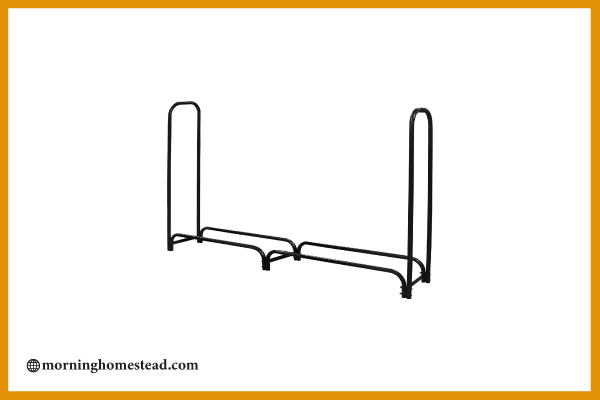
Landmann USA Landmann 82433 8-Foot Firewood Log Rack Only, 8-Feet, Black
- Sturdy and durable, made from tubular steel with a Black Weatherproof powder coat finish
- Neatly stacks firewood off of the ground
- Protects firewood from the dampness of the ground
- High capacity storage; holds 2/3 Face cord of wood
- Sturdy steel construction Designed for easy assembly
Firewood Tools for Every Homesteader
Assuming your firewood has already been cut to the appropriate length, or close to it, for your stove, you’ll still want to have a few everyday, useful tools for your firewood use.
You may occasionally need to split a larger piece up either because it is too big for your stove, or because you need kindling. Also, think about how you are going to carry your firewood into your home.
A Chainsaw
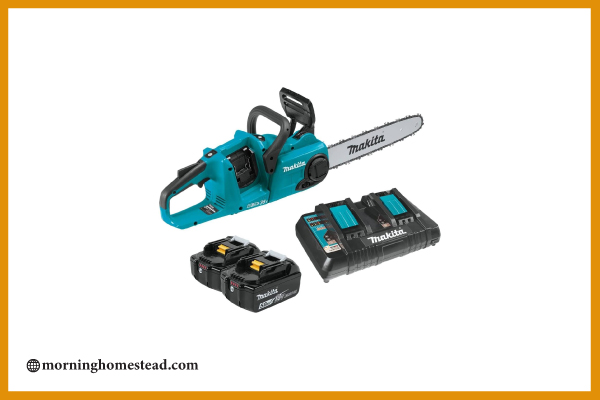
You can purchase either an electric, or gas chainsaw. Electric chainsaws have the advantage of being lightweight and easy to use for smaller tree limbs and logs. But for portability and power, you’ll want to go with a gas saw.
Saw length varies from 12″ and up. Most homeowners make do with a 16″ length saw.
Makita XCU03PT1 18V X2 (36V) LXT Lithium-Ion Brushless Cordless 14″ Chain Saw Kit with, 4 Batteries (5.0Ah) , Blue
- 2 Free Batteries with qualifying X2 kits for a limited time (4 batteries included)
- Variable speed trigger and high chain speed (0-3, 940 FPM) For improved cutting performance
- “Toolless” chain adjustment for convenient operation and maintenance. Chain pitch: 3/8 inch
- A built-in lock-off lever helps prevent the chain from accidentally engaging
- Built-in L. E. D. On/off switch with auto power-off function; automatically shuts the saw off when the operation is delayed for extended Battery life
An Iron Wedge
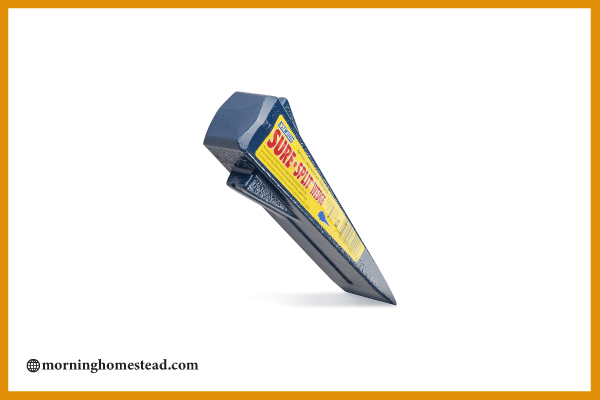
Driven with the sledgehammer to split a piece into smaller sections. Also commonly used to chop small pieces of wood is a hatchet.
Estwing Sure Split Wedge – 5-Pound Wood Splitting Tool with Forged Steel Construction & 1-7/8″ Cutting Edge – E-5, Blue
- WOOD SPLITTING MADE EASY – Weighted wedge design makes chopping logs and firewood a breeze
- WEDGE VERSATILITY – The Sure Split fins permit extra wedge action and the sled will continue throughout below the wood line for sure splitting
- PERFECT FOR THE OUTDOORSMAN – Ideal for campers, hunters, hikers, and other outdoor enthusiasts
- HAND SHARPENED – Honed cutting edge for easy wood splitting
- MADE IN THE USA – Our tools are proudly crafted in Rockford, IL using the finest American steel
A Sledge Hammer
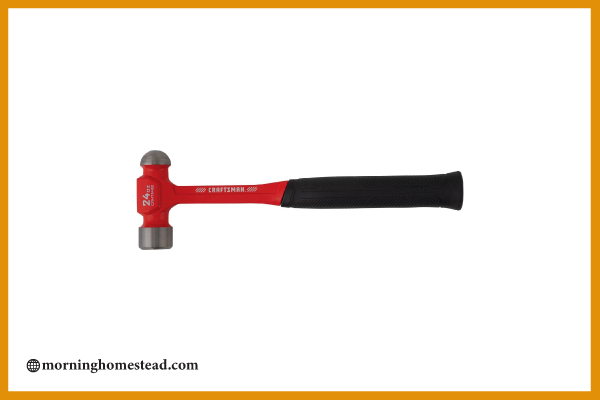
A sledgehammer is a robust, heavy hammer used to pound a wedge into the wood.
CRAFTSMAN Sledge Hammer, 10-Pound (CMHT56019)
- Bullet nose design provides 2x more concentrated striking force
- Particulate-filled fiberglass core and shock-absorbing collar help reduce vibrations on impact
- Over-mold textured grip for added comfort and control
- Shatterproof fiberglass handle provides better** durability
- Full Lifetime Warranty, refer to the “Warranty & Support” section below for full details
A Splitting Maul
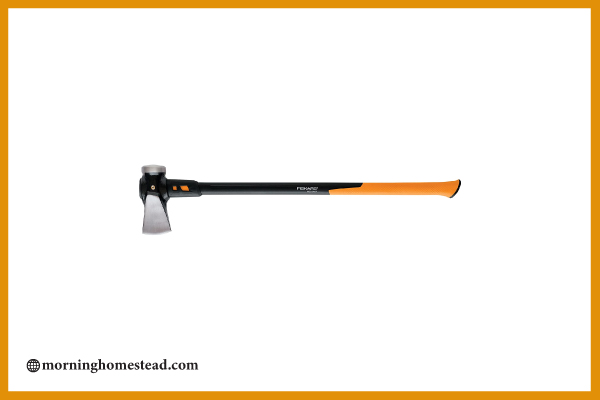
The most commonly used tool for splitting wood is a splitting maul which is essentially the sledgehammer with the wedge attached. The flat edge can also be used as a sledgehammer to pound a wedge further in.
Sale
Fiskars 378841-1002 X27 Super (36″) Splitting Axe
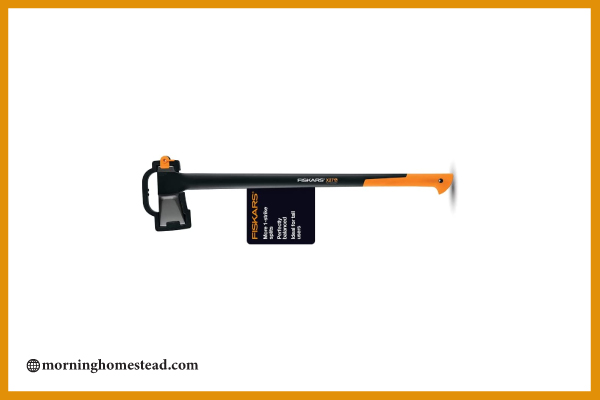
- Ideal for taller users splitting medium- to large-sized logs
- Designed for maximum efficiency to give you more one-strike splits. A textured non-slip grip reduces hand strain and improves control
- Perfected balance and power-to-weight ratio increase swing speed to multiply power, much like an aluminum baseball bat
- Advanced bevel convex blade geometry adds power and makes the blade easier to remove from wood
- Lifetime warranty. Item weight: 5.85 pounds
An Automatic Wood-Splitter
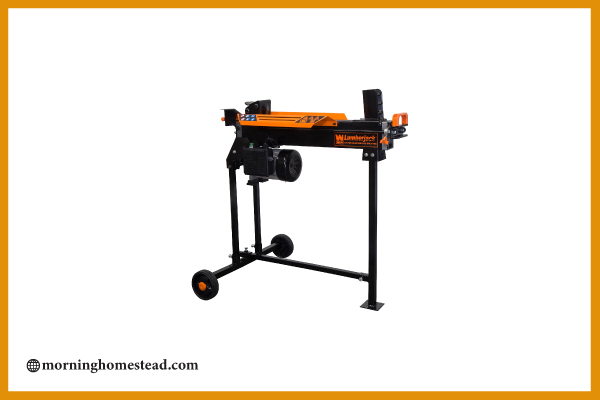
A hydraulic cylinder that replaces the need to manually split. These are great for splitting logs into kindling. More expensive, but potentially worth it if you are planning to do a lot of wood splitting over time.
Sale
WEN 56207 6.5-Ton Electric Log Splitter, Black
- A powerful 15A motor provides over 13,000 pounds of log-cracking pressure
- Use the log splitter with or without the 34-inch stand depending on user preferences
- Included pull handle and 5.5-inch never-flat wheels make for easy transportation between jobs
- Electric power means no gasoline, no carbon monoxide emissions, and limited maintenance
- Split logs up to 10 inches in diameter and 20.5 inches in length
Safety Gear for Splitting Wood
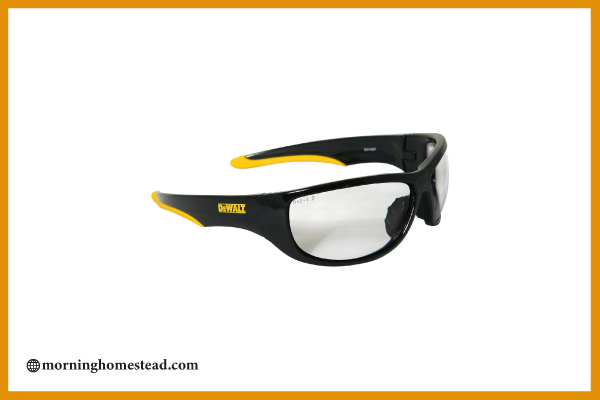
Always wear appropriate safety gear before splitting firewood. Even a simple swing of the sledgehammer can fling a sliver of wood into your eye causing permanent damage.
- Safety Glasses for protection against sawdust and flying debris
- Hearing protection if using a chainsaw or other loud equipment
- Heavy-duty, rugged clothing that provides protection to your skin, but is not loose or easy to get caught in equipment.
- Chaps (especially important when using a chainsaw!)
- Heavy-duty gloves
Of course, already read, and follow, all safety manuals that come with equipment, and the best practice is to split wood with a partner in case of an accident.
DEWALT DPG94-1C Dominator SAFETY Glasses, Clear Lens
- Rubber-tipped temples provide a non-slip comfortable fit
- A full frame with a larger lens provides excellent coverage
- Integrated rubber nosepiece for longer, comfortable wear
- Protects against 99. 9-Percent harmful UV rays
- Meets ANSI Z87. 1+ standards
G & F Products G & F 5215L-5 Premium Suede Double Palm & Index Finger Work Gloves with 2 & 1/2 Rubberized Safety Cuff, 5 Pair Pack, Large

- 100% Premium suede cowhide leather double palm work gloves, 5-pair pack
- Rubberized safety cuff
- A double leather layer covers the palm and index finger
- 100% cotton Back
Forester OEM Arborist Forestry Professional Cutter’s Combo Kit Chaps Helmet FORCHG
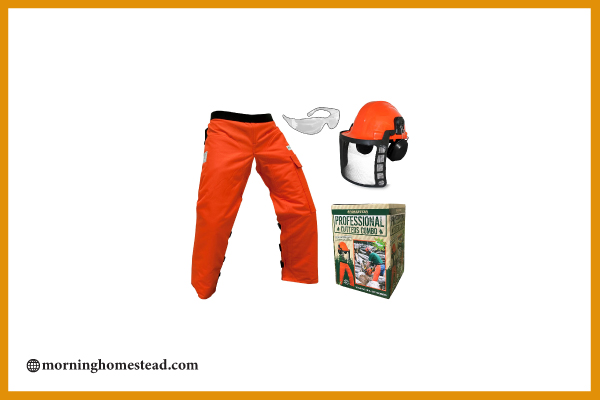
- All-In-One Package Available! ANSI Z87.1/UV400 Approved Clear Safety Glasses Forestry Helmet: Meets ANSI/ISEA Z89.1-2009 Type 1, Class E, G & C/Screen meets Basic ANSI Z87.1 Requirements. Muffs: Meet ANSI S12.42 21dB Rating Chaps: Apron Style. UL Classified and tested in accordance with ASTM F1897 Standards for leg protective garments (For USA)
Forester Chainsaw Safety Safety Chainsaw Chaps – Logging Tools Chainsaw Safety Gear with Pocket, Chainsaw Apron Chaps Style, Orange
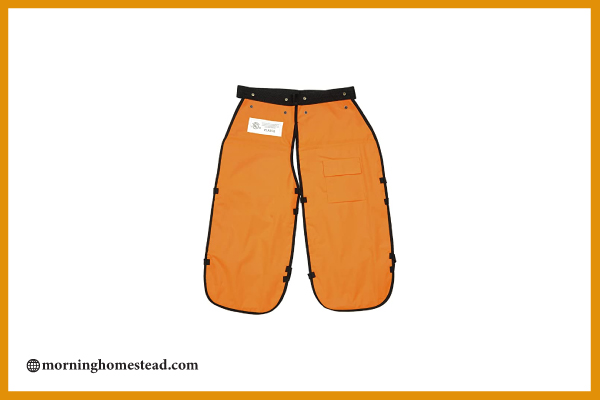
Carrying Tools for Your Wood
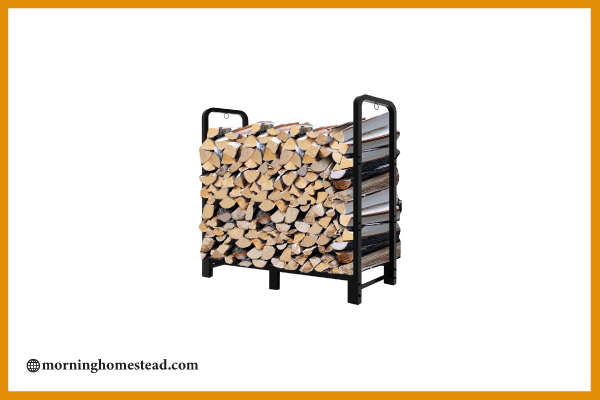
It is perhaps a luxury, but a nice one, to have a convenient and easy-to-use lug or sack to carry your firewood in. A simple box or basket can do the trick in a pinch, but a rugged, heavy-duty carrier or firewood rack will make the job easy and last for years.
COLIBROX Heavy Duty Steel Firewood Log Rack Dolly Cart Carrier Trolley Wood Mover Hauler
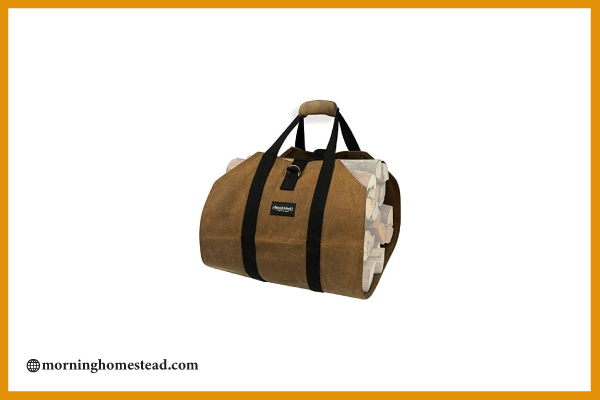
Amagabeli Fireplace Carrier Waxed Firewood Canvas Log Carrier Tote Bag Outdoor Log Tote Large Wood Carrying Bag with Handles Security Strap Camping Indoor Firewood Log Holder Birchwood Stand Brown
- Large Log Capacity: Constructed from premium waxed canvas. 39″ Long x 18″ Wide, an excellent size for carrying a few logs, firewood, kindling, and twigs. Perfect for transporting big chunks of oak and maple logs from your woodpile to your fireplace. The no-end wall design works great to carry a fair amount of firewood of any size. because it doesn’t limit the length of wood pieces you can carry.
- Convenient to Use: The firewood log carrier tote bag is well-built, lightweight, and handy, making for a cleaner and neater process for carrying firewood into your house. Padded handles save your fingers when carrying an amount of firewood. An adjustable central strap for securing and tightening the firewood or logs while loaded. It will keep the bundle neat and tight inside the canvas firewood carrier.
- Water Resistant & Durable Waxed Canvas: large firewood carrying bag is a waterproof material that is very nice when you have to set it down in the snow, durable, and easy to clean. Provides years of heavy use without tearing – even during the coldest, harshest winters.
- Easy To Storage: The fire log carrier bag is easy to fold up and store away for an indoor firewood rack. It could be hung by the straps or folded up (wads up or crushes down) compactly for storage when not in use for saving space. Camp Outs gathering wood for camping.
- Customer Care: We are dedicated to providing premium products for you and offer impeccable customer care to you. Don’t wait any longer and just enjoy your ideal products today!



![HUSQVARNA 440 Vs 440E Vs 445: Reviews And Comparison Guide [2023] HUSQVARNA-440-Vs-440E-Vs-445-Reviews](https://morninghomestead.com/wp-content/uploads/2019/06/HUSQVARNA-440-Vs-440E-Vs-445-Reviews-150x150.jpg)

